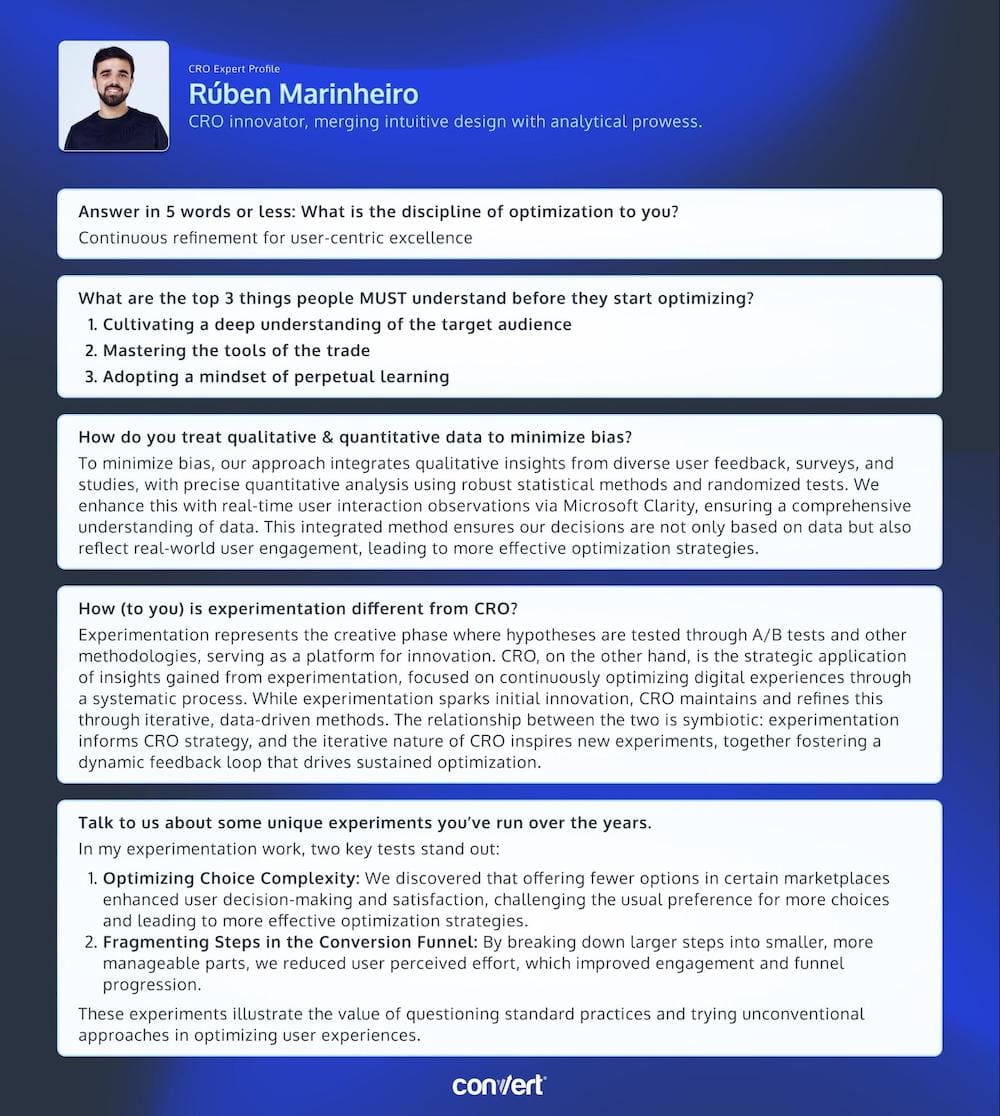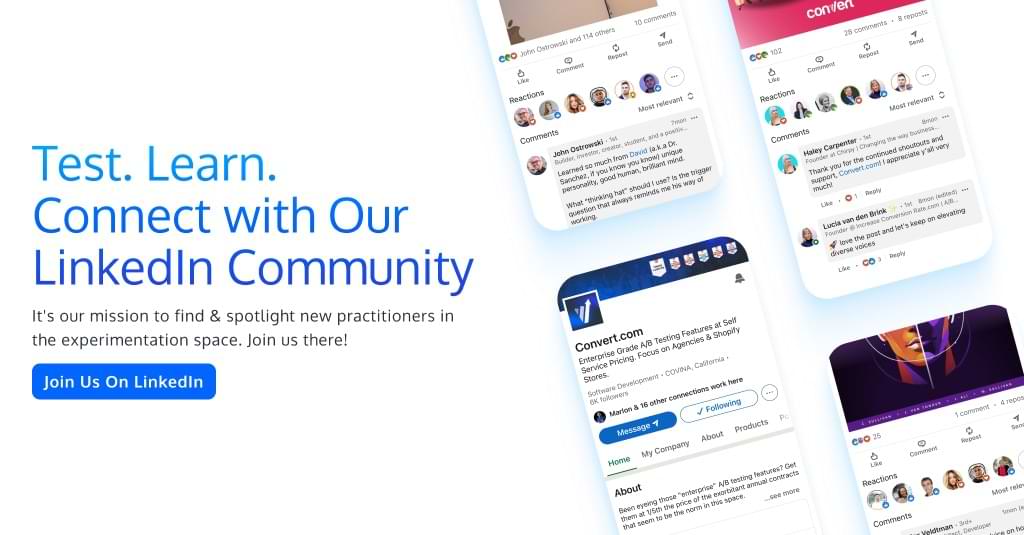Testing Mind Map Series: How to Think Like a CRO Pro (Part 51)
Interview with Rúben Marinheiro
We’re kicking off 2024 with a killer interview. At just 23, Rúben’s taking the CRO scene by storm, all thanks to a mentor who spotted his talent for optimization early on. With roots in web design and ecom, he combines intuitive design with a deep understanding of analysis to create better user experiences.
For Rúben, experimentation is the sandbox where hypotheses are tested. CRO is where these ideas mature into strategies. It’s a ‘dynamic feedback loop’ of creative exploration and data-driven decision-making, each feeding into the other.
So, get ready to be inspired by this young gun, who’s unabashedly breaking the ‘rules’ of CRO…
Rúben, tell us about yourself. What inspired you to get into testing & optimization?
Hello, I’m Rúben Marinheiro, a 23-year-old Conversion Rate Optimization Specialist at Parfois, a prominent brand specializing in fashion and women’s accessories.
Getting into testing and optimization was more of a serendipitous journey than a deliberate choice. Early in my career, I was deeply immersed in the world of web design at KuantoKusta, Portugal’s largest online marketplace. It was during this phase that Bruno Mota, my manager at the time, keenly identified my skills and potential for taking on testing and optimization projects.
His discernment became the driving force that led me into this captivating field. The realization that I could make substantial contributions to testing and optimization projects sparked a passion that has since become the bedrock of my professional journey. This wasn’t just a career pivot but a recognition of my inherent aptitude for this domain.
As a bit of curiosity, I’m just 23 years old—a detail that might stand out, as it’s not very common to find individuals my age in this field. I want to express my sincere gratitude to Bruno and the entire KuantoKusta team for believing in me. Their support and trust served as the most invaluable launchpad for my career, and I couldn’t have asked for a better foundation.
How many years have you been testing for?
I’ve been in the testing and optimization realm since 2019, but my involvement with web design and e-commerce dates back to my earlier years, providing a solid foundation for my current role at Parfois.
What’s the one resource you recommend to aspiring testers & optimizers?
In navigating the dynamic world of testing and optimization, my advice would be to explore a variety of resources tailored to your learning style. Online platforms like Udemy, Coursera, and industry-specific blogs offer a wealth of practical insights, real-world case studies, and hands-on experiences. Engage with the community, attend webinars, and never underestimate the power of peer-to-peer learning.
LinkedIn, when strategically leveraged, emerges as an excellent source of industry information. Connect with professionals, join relevant groups, and participate in discussions to stay abreast of emerging trends. Also, don’t miss out on the valuable insights shared by Convert here and on LinkedIn. Following their posts can provide a steady stream of current and practical information, enriching your understanding of the field and offering actionable tips for successful testing and optimization.
Answer in 5 words or less: What is the discipline of optimization to you?
In 5 words: Continuous refinement for user-centric excellence.
Optimization is a perpetual refinement for excellence, an ongoing journey that harmonizes user-centric insights, creative ideation, and data-driven precision to craft digital experiences that resonate and convert.
What are the top 3 things people MUST understand before they start optimizing?
Before embarking on the optimization journey, it’s imperative to grasp the significance of user understanding, tool mastery, and the commitment to continuous learning. These pillars form the bedrock of successful optimization endeavors, ensuring a holistic approach to enhancing digital experiences.
First and foremost, cultivating a deep understanding of the target audience is paramount. It involves deciphering user behaviors, preferences, and pain points, laying the groundwork for informed optimization strategies.
Secondly, mastering the tools of the trade is non-negotiable. Whether it’s proficiency in A/B testing platforms, analytics tools, or other optimization software, a comprehensive skill set empowers practitioners to extract meaningful insights and execute impactful experiments.
Lastly, adopting a mindset of perpetual learning is crucial. The digital landscape is dynamic, and staying abreast of emerging trends, technologies, and user behaviors is integral to sustained success in optimization. Embracing a learning-oriented approach fuels innovation and keeps optimization strategies relevant and effective.
How do you treat qualitative & quantitative data to minimize bias?
In our data-driven approach to optimization, we employ a multifaceted strategy that combines the richness of qualitative insights with the precision of quantitative data. Here’s how we navigate the complexities:
- Diverse Qualitative Insights:
- User feedback, surveys, and usability studies provide a qualitative lens into the emotional and behavioral dimensions of user interactions.
- Rigorous sampling techniques ensure a diverse representation of user perspectives.
- Systematic coding and categorization processes enhance the reliability and validity of our qualitative findings.
- Quantitative Precision:
- Robust statistical methods analyze large datasets from A/B tests and experiments.
- Randomization of test groups and elimination of confounding variables uphold the integrity of our quantitative insights.
- Stringent statistical significance thresholds contribute to the accuracy of our data interpretations.
- Real-Time Observation with Microsoft Clarity:
- Beyond conventional analyses, we immerse ourselves in the user experience.
- Microsoft Clarity serves as a powerful tool, allowing real-time observation of how users interact with our test versions.
- Bridging the gap between data and real-world behavior, this approach minimizes biases inherent in isolated datasets.
- Integrated Decision-Making:
- Our optimization strategies transcend statistical interpretations alone.
- Enriched by real-world user experiences, they are founded on a comprehensive understanding.
- This integrated approach ensures that decisions are not only data-backed but also resonate with the actual dynamics of user engagement, fostering a robust foundation for optimization.
How (to you) is experimentation different from CRO?
Experimentation, to me, is the creative exploration phase where hypotheses are tested, and insights are unearthed. It’s the dynamic playground where innovative ideas come to life through A/B tests, multivariate experiments, and other testing methodologies.
CRO, on the other hand, is the ongoing, strategic application of insights derived from experimentation. It’s the systematic process of leveraging what we’ve learned to optimize digital experiences continuously. While experimentation fuels the initial spark of innovation, CRO is the sustained flame that propels iterative refinement based on proven insights.
The synergy between experimentation and CRO is akin to a dynamic feedback loop. Insights from experiments inform the overarching CRO strategy, and the iterative nature of CRO continually inspires new experiments. It’s a symbiotic relationship where creativity and data-driven decision-making coalesce to drive sustained optimization.
Talk to us about some unique experiments you’ve run over the years.
In my journey of experimentation, a couple of particularly intriguing tests come to mind, challenging conventional wisdom and yielding insightful results:
- Optimizing Choice Complexity:
- Contrary to the conventional belief that more options are better, we explored scenarios in a marketplace where offering users fewer choices proved more positive.
- Limiting options enhanced decision-making for users, resulting in a more streamlined and satisfying shopping experience.
- This unexpected outcome underscored the importance of understanding user behavior in specific contexts, leading to more tailored optimization strategies.
- Fragmenting Large Steps in the Funnel:
- One experiment focused on breaking down substantial steps in the conversion funnel into smaller, more manageable components.
- The rationale was to reduce the perceived commitment of users, encouraging them to progress further in the funnel.
- This approach proved highly effective, demonstrating that minimizing the perceived effort enhances user engagement and propels them through the funnel more efficiently.
These experiments highlight the dynamic nature of optimization, where challenging assumptions and embracing unconventional strategies can yield valuable insights that reshape our approach to enhancing user experiences.
These experiments highlight the dynamic nature of optimization, where challenging assumptions and embracing unconventional strategies can yield valuable insights that reshape our approach to enhancing user experiences.
Download the infographic above and add it to your swipe file for a little inspiration when you’re feeling stuck!
Our thanks go out to Rúben for taking part in this interview! To our lovely readers, we hope you found the insights useful and encourage you to apply them in your own optimization efforts.
Don’t forget to check back twice a month for more enlightening interviews! And if you haven’t already, check out our past interviews with CRO pros Gursimran Gujral, Haley Carpenter, Rishi Rawat, Sina Fak, Eden Bidani, Jakub Linowski, Shiva Manjunath, Deborah O’Malley, Andra Baragan, Rich Page, Ruben de Boer, Abi Hough, Alex Birkett, John Ostrowski, Ryan Levander, Ryan Thomas, Bhavik Patel, Siobhan Solberg, Tim Mehta, Rommil Santiago, Steph Le Prevost, Nils Koppelmann, Danielle Schwolow, Kevin Szpak, Marianne Stjernvall, Christoph Böcker, Max Bradley, Samuel Hess, Riccardo Vandra, Lukas Petrauskas, Gabriela Florea, Sean Clanchy, Ryan Webb, Tracy Laranjo, Lucia van den Brink, LeAnn Reyes, Lucrezia Platé, Daniel Jones, May Chin, Kyle Hearnshaw, Gerda Vogt-Thomas, Melanie Kyrklund, Sahil Patel, Lucas Vos, David Sanchez del Real, Oliver Kenyon, David Stepien, Maria Luiza de Lange, Callum Dreniw, and our latest with Shirley Lee.
Written By
Rúben Marinheiro
Edited By
Carmen Apostu



